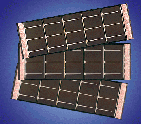Scientists move a step closer to high-efficiency plastic solar cells
 Washington, March 18: US and Austrian scientists have made a significant advance towards the next generation of plastic solar cells that may help replace inorganic solar cells, and provide a cheaper but environmentally-friendly way to meet the rising demands of energy.
Washington, March 18: US and Austrian scientists have made a significant advance towards the next generation of plastic solar cells that may help replace inorganic solar cells, and provide a cheaper but environmentally-friendly way to meet the rising demands of energy.
Alan J. Heeger, an expert at the University of California at Santa Barbara, says that the new plastic solar cells have been fabricated from bulk heterojunction materials comprising semiconducting polymers and fullerenes.
He and his colleagues have already found these cells to show promising performance in a study.
The researchers, however, are still unclear on how to control the nano-scale morphology, and are looking for ways to optimise the solar cell performance for practical use.
Heeger, co-recipient of the Nobel Prize in Chemistry in 2000 for his pioneering research on conducting polymers, is well-known for his ongoing works to improve solar cell efficiencies.
The latest study conducted by Heeger and his colleagues revealed that adding a class of chemicals called alkanedithiols as processing additives improves both the morphology and the solar cell performance.
The researchers observed that the efficiency of the plastic solar cells increased from 3.4 per cent to 5.1 per cent upon using alkanedithiols as processing additives.
The significance of this finding lies in the fact that it is among the highest efficiencies achieved to date for this type of solar cell.
“These data provide a better understanding of correlation between the nano-scale morphology of the bulk heterojunction film and the solar cell performance,” the researchers write in their study report, scheduled for publication in the March 19 issue of ACS’ Journal of the American Chemical Society. (ANI)